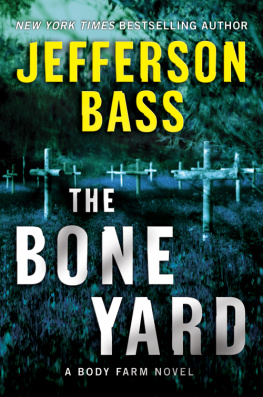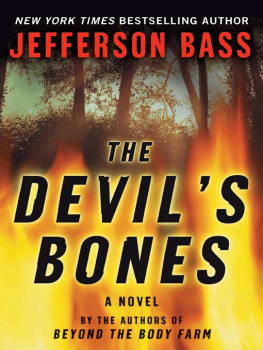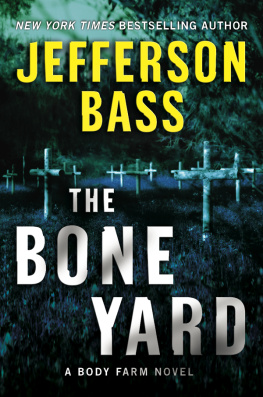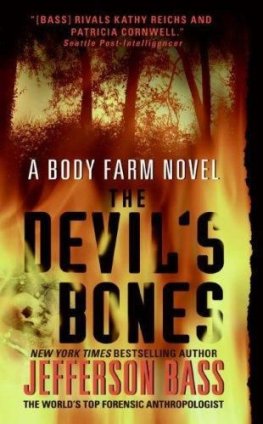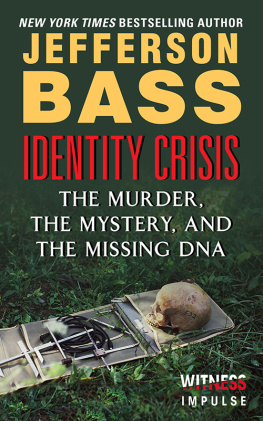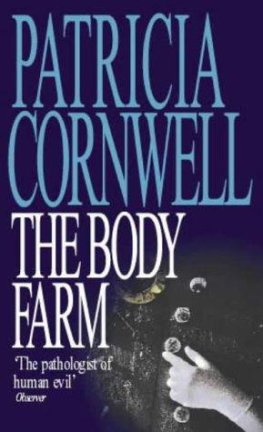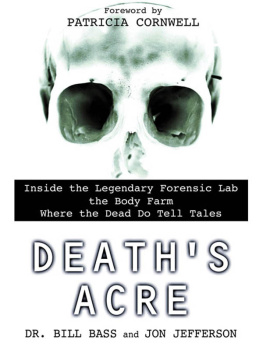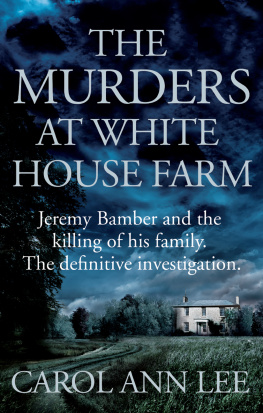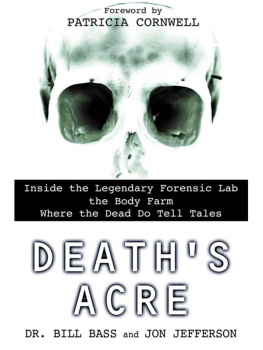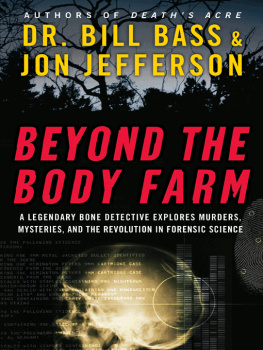Advances in the science of forensic anthropology, which plays a crucial role in the cases in this series, would not have been possible without the research and experimentation by my many graduate students. To them, I offer my greatest respect.
After the publication of Carved in Bone, I was surprised at the number of people who bonded with the characters in that first novel. Now, though, as weve worked on this second one, Ive become much more attached to our characters, tooso much so that I miss those who are not around. As I shed tears for one of them, I reflected that I could not have found a better writer to collaborate with than Jon Jefferson.
To my wife, Carol, who has difficulty separating the fiction from the facts in the Body Farm novels, I offer my sincere thanks for her support. Carol claims she knows who the student is that Dr. Bill Brockton kissed in Carved in Bone . I say, Carol, this is all fiction. She says, Art Bohanan is not fiction.
Dr. Bill Bass
My forensic discussions with Bill Bass, and my lunches with Bill and Carol, rank high on my list of lifes delights. Its always fun when the discussion in our restaurant booth makes nearby heads turnor makes Carols cheeks go crimson. Art Bohananreal-life fingerprint expert and childrens advocatehas been remarkably gracious about letting us borrow from his cases and his causes, and were proud to dedicate this book to the memory of his son.
Knoxville Police Department investigators Tom Evans and Tim Snoderly shared their time and insights generously, as did the staff at the booking and detention facility of the Knox County Sheriff s Office, especially Sgt. Robert Anderson.
From one side of the courtroom, criminal defense attorney David Eldridgeas smart as Burt DeVriess, but far less slipperycoached me on defense strategy; from the opposite side, Assistant District Attorney Jennifer Welch helped me untangle the Gordian knot of criminal-court procedures.
Forensic technology is getting more sophisticated all the time; for sharing their time and technical expertise, I thank forensic audio and video consultant Tom Owen as well as Doug Perkins and John Laycock of Ocean Systems.
Elaine Giardino, parish administrator of St. Pauls Episcopal Church in Chattanooga, kindly escorted me through the nooks, crannies, and staircases of her lovely church. I explored the nooks and crannies of the Hamilton County medical examiners facility thanks to Tom Bodkin, the staff forensic anthropologist there (another of Dr. Basss bright and successful protgs), and his boss, Medical Examiner Frank King, M.D. In Knoxville, at the Regional Forensic Center, I also owe a debt of gratitude to Knox County Medical Examiner Sandra Elkins, M.D., who drives a sports car but does not, as far as I know, resemble Jess Carter in any other personal respects.
For insights into the Scopes trial, I extend my gratitude both to University of Missouri law professor Douglas Linder (who has a fascinating series of websites about great trials) and to Richard Cornelius, a Scopes historian and the curator of the Scopes Evolution Trial Museum in Dayton, Tennessee.
Im grateful to JJ Rochelle, John Craig, David Brill, and Sybil Wyatt, dear friends and true; to my sister Sara, for seeing me through a move to Baltimore; and to sweet, smart, sassy, and ever-capable Cindy.
Our agent, Giles Anderson, continues to do a spectacular job of keeping us off the streets and happily writing. We have a wonderfully supportive team at William Morrow: Sarah Durand, editor extraordinaire; crack publicists Seale Ballenger, Eryn Wade, and Buzzy Porter; marketing geniuses Rachel Bressler and Kevin Callahan; and sales wizards Brian McSharry, Michael Morris, Mike Spradlin, and Carla Parker. Were also grateful to everyone who succeeded in getting us off those shelves, including booksellers who have recommended us andespeciallyreaders who have responded so warmly to Dr. Bill Brockton, Art, and their sundry partners in crime.
Finally, profound gratitude to Seabiscuit, who galloped through these pages with me and helped make them smarter and better. What a beautiful, brilliant ride.
Jon Jefferson
CARVED IN BONE
J EFFERSON B ASS is the writing team of Dr. Bill Bass and Jon Jefferson. Dr. Bass, a world-renowned forensic anthropologist, founded the University of Tennessees Anthropology Research Facilitythe Body Farma quarter century ago. He is the author or coauthor of more than two hundred scientific publications, as well as a critically acclaimed memoir about his career at the Body Farm, Deaths Acre. Dr. Bass is also a dedicated teacher, honored as National Professor of the Year by the Council for Advancement and Support of Education. Jon Jefferson is a veteran journalist, writer, and documentary filmmaker. His writings have been published in the New York Times, Newsweek, USA Today, and Popular Science and broadcast on National Public Radio. The coauthor of Deaths Acre, he is also the writer and producer of two highly rated National Geographic documentaries about the Body Farm.
www.JeffersonBass.com
Visit www.AuthorTracker.com for exclusive information on your favorite HarperCollins author.

Australia
HarperCollins Publishers (Australia) Pty. Ltd.
25 Ryde Road (PO Box 321)
Pymble, NSW 2073, Australia
http://www.harpercollinsebooks.com.au
Canada
HarperCollins Publishers Ltd.
55 Avenue Road, Suite 2900
Toronto, ON, M5R, 3L2, Canada
http://www.harpercollinsebooks.ca
New Zealand
HarperCollinsPublishers (New Zealand) Limited
P.O. Box 1
Auckland, New Zealand
http://www.harpercollinsebooks.co.nz
United Kingdom
HarperCollins Publishers Ltd.
77-85 Fulham Palace Road
London, W6 8JB, UK
http://www.harpercollinsebooks.co.uk
United States
HarperCollins Publishers Inc.
10 East 53rd Street
New York, NY 10022
http://www.harpercollinsebooks.com
THE CHAIN-LINK GATE YOWLED like an angry tomcat in the watery light of dawn. Once my jaw unclenched, I made a mental note to bring grease for the hinges next time I came out to the Body Farm. Dont forget, I chided myself, just as I had each of the past half dozen times Id mentally made and mislaid that same damn note.
It wasnt that my memory was failing, or so I liked to believe. It was just that every time I headed for the Anthropology Research Facility, as the University of Tennessee preferred to call the Body Farm, I had more interesting things on my mind than WD-40. Things like the experiment I was about to rig with the body in the pickup truck Miranda was backing toward the facilitys gate.
It never ceased to amaze me, and to frustrate me, that the Body Farm remained the worlds only research facility devoted to the systematic study of postmortem decomposition. As an imperfect human being, with failings and vanities, I did take a measure of pride in the uniqueness of my creation. As a forensic anthropologist, thougha bone detective who had branched out into seeking clues in decaying flesh as wellI looked forward to the day when our data on decomp rates in the moist, temperate climate of Tennessee could be compared with rates from similar research facilities in the low desert of Palm Springs, the high desert of Albuquerque, the rain forest of the Olympic Peninsula, or the alpine slopes of the Montana Rockies. But every time I thought a colleague in one of those ecosystems was on the verge of creating a counterpart to the Body Farm, the university in question would chicken out, and we would remain unique, isolated, and scientifically alone.


